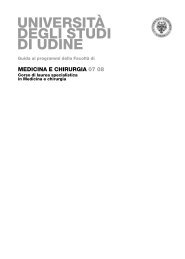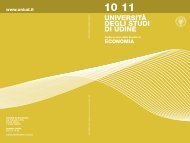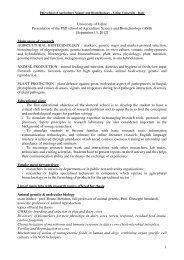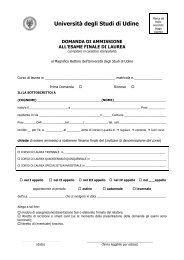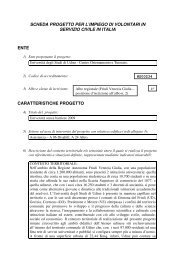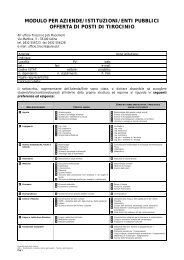â¢GUIDA ECONOMIA 07-08 - Università degli studi di Udine
â¢GUIDA ECONOMIA 07-08 - Università degli studi di Udine
â¢GUIDA ECONOMIA 07-08 - Università degli studi di Udine
Create successful ePaper yourself
Turn your PDF publications into a flip-book with our unique Google optimized e-Paper software.
prospectus u<strong>di</strong>ne<br />
243<br />
- D.M. LEVINE, T.C. KREHBIEL, M.L. BEREN-<br />
SON, Statistica, Apogeo, Milano, 2002.<br />
- G. CICCHITELLI, Probabilità e statistica,<br />
second e<strong>di</strong>tion, Maggioli E<strong>di</strong>tore, Rimini,<br />
2001.<br />
Exam<br />
Evaluation: To receive cre<strong>di</strong>ts students<br />
must complete two written assignments,<br />
a midterm examination, and a final examination.<br />
STATISTICS<br />
(CdL SCSBM)<br />
Prof. Ruggero Bellio<br />
Aims<br />
The course provides an introduction to<br />
basic methods of statistical inference.<br />
Contents<br />
1. Complementary elements of probability<br />
theory. Basic sampling theory.<br />
2. The concept of a statistical model.<br />
Model specification and model checking.<br />
3. Point estimation.<br />
4. Testing.<br />
5. Confidence intervals and regions. Pre<strong>di</strong>ction<br />
problems.<br />
Bibliography<br />
Main text<br />
- L. PACE, A. SALVAN, Introduzione alla Statistica,<br />
II, Inferenza, verosimiglianza, modelli,<br />
Cedam Padova, 2001.<br />
Supplementary texts<br />
- M. GRIGOLETTO, L. VENTURA, Statistica<br />
per le scienze economiche, Giappichelli,<br />
Torino, 1998.<br />
- G. CICCHITELLI, Probabilità e Statistica,<br />
second E<strong>di</strong>tion, Maggioli E<strong>di</strong>tore, 2001.<br />
STATISTICS FOR<br />
ECONOMIC ANALYSIS<br />
Prof. Gian Pietro Zaccomer<br />
Aims<br />
The course is the logical continuation of<br />
Statistical Measurement of Economics<br />
Phenomena. While the first course illustrates<br />
the elements to understand and<br />
measure economic values, the second<br />
course focuses on the main methods of<br />
statistical analysis, in time and space, of<br />
economic phenomenon.<br />
Contents<br />
1 Analysis of economic values in time<br />
1.1 Introduction to time series analysis.<br />
Variation of economic time aggregates.<br />
Graphic analysis of time series. Classical,<br />
stochastic and structural analysis.<br />
Hypothesis of decomposition model.<br />
1.2 Stationarity of series. Linear and nonlinear<br />
trends. Variable transformations.<br />
Regression and moving averages.<br />
1.3 Economic cycle and turning points.<br />
The concept of economic hysteresis.<br />
1.4 Season and methods of seasonal<br />
adjustment for time series.<br />
1.5 Residual component analysis.<br />
1.6 Outlines on time series forecasting.<br />
2 Analysis of economic values in space<br />
2.1 Introduction of analysis and characteristics<br />
of spatial data. Analysis for<br />
points, lines and areas. Regular and irregular<br />
grids. Administration <strong>di</strong>visions. Triangulation<br />
methods and the creation of<br />
gravitational areas.<br />
2.2 In<strong>di</strong>cators for socioeconomic territorial<br />
analysis. Classic shift-share analysis.<br />
2.3 Contiguity and connection matrices.<br />
Spatial shift-share analysis.<br />
2.4 Spatial autocorrelation and its measures.<br />
2.5 The main problems of statistical modeling<br />
with spatial data. Territorial reorganization<br />
by means of in<strong>di</strong>cators, flows<br />
and cluster analysis.




